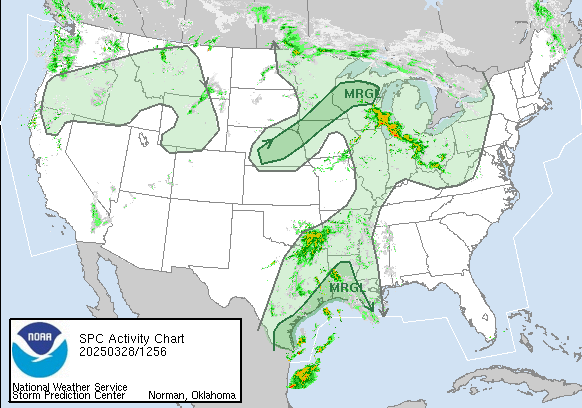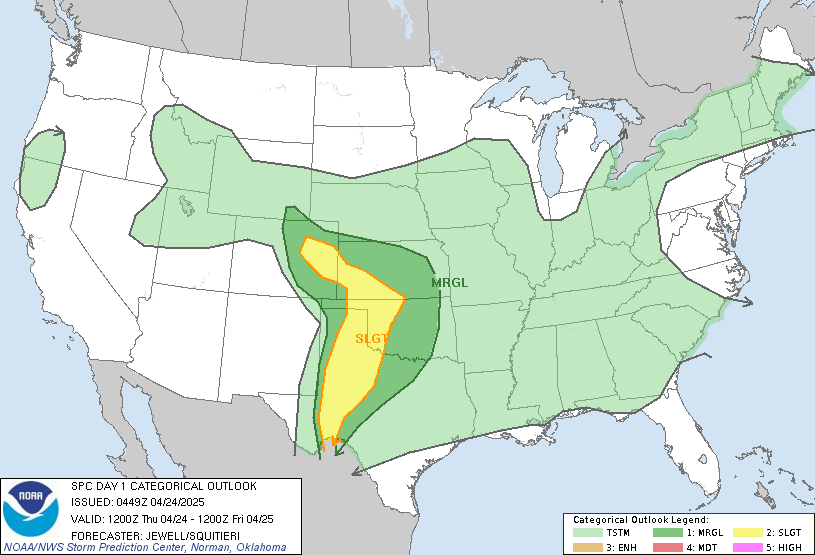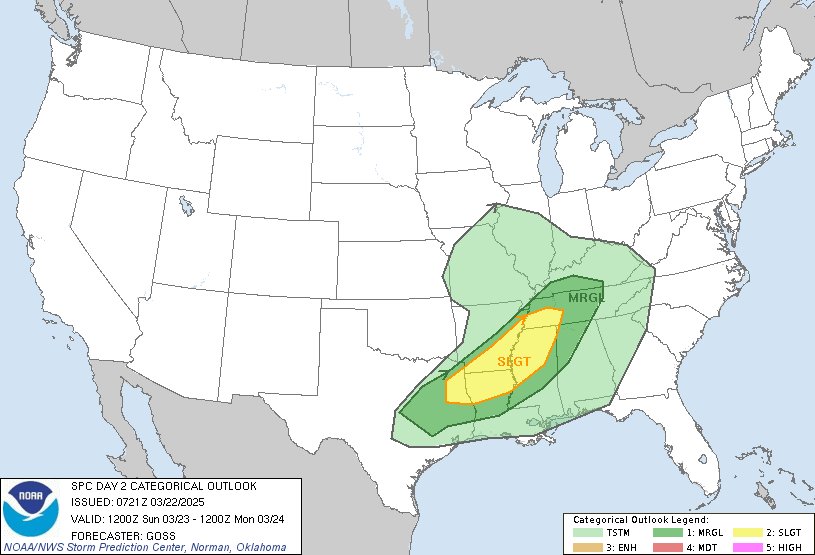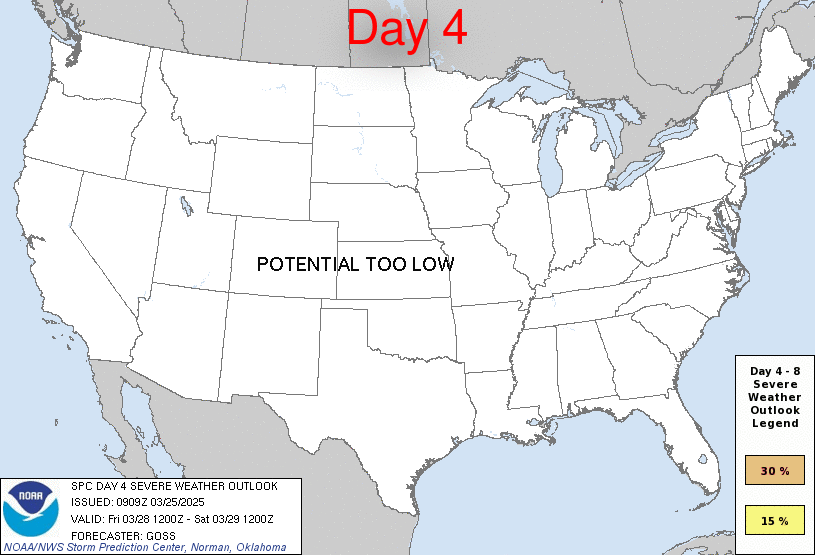The Storm Prediction Center convective weather outlook is part of the National Weather Service (NWS) and the National Center for Environmental Prediction (NCEP). Their mission is to provide accurate forecasts and monitor the timing of thunderstorms and severe storms in the United States. The SPC provides convective outlooks on Day 1, Day 2, and Day 3 that reflect the overall level of severe weather hazard outlooks through a list of forecast statistics. This data identifies areas at risk of mild thunderstorms and severe thunderstorms. For more information on how to read this map, please see the bottom of this page.

Convective Outlook Day 1

SPC Day 1 Outlook Discussion
ACUS01 KWNS 050035 SWODY1 SPC AC 050033 Day 1 Convective Outlook NWS Storm Prediction Center Norman OK 0633 PM CST Thu Dec 04 2025 Valid 050100Z - 051200Z ...NO SEVERE THUNDERSTORM AREAS FORECAST... ...SUMMARY... A few thunderstorms are expected near/along the northern Gulf Coast tonight. ...01z Update... Low-amplitude short-wave trough is advancing east-northeast across the lower MS Valley early this evening. A corridor of weak convection is noted ahead of this feature from southeast LA into southwest AL. The deepest, more robust updrafts over southeast LA are generating a few flashes of lightning. Surface-based buoyancy is not expected to materialize inland through sunrise, and any thunderstorm activity near the Gulf Coast will be driven in large part by warm advection, and should remain elevated. Midlevel instability appears too weak to warrant any meaningful risk for severe. ..Darrow.. 12/05/2025 $$ |
Convective Outlook Day 2

SPC Day 2 Outlook Discussion
ACUS02 KWNS 041729 SWODY2 SPC AC 041728 Day 2 Convective Outlook NWS Storm Prediction Center Norman OK 1128 AM CST Thu Dec 04 2025 Valid 051200Z - 061200Z ...NO SEVERE THUNDERSTORM AREAS FORECAST... ...SUMMARY... Severe storms are not forecast Friday. ...Synopsis... Broad mid-level troughing over the eastern US is forecast to continue Friday as several small-scale perturbations pass over the Plains and Midwest. At the surface, a low will deepen over the northern Rockies while a stalled front will remain in place along the Gulf Coast. Behind the front, a cold and dry polar air mass will largely preclude thunderstorm development over much of the US. The exception will be along the central and northeastern Gulf Coast where a few thunderstorms are possible early. ...Southern LA to the FL Panhandle... Along the stalled front, a weak wave low is forecast to develop across the northern Gulf ahead of a low-amplitude shortwave moving out of the southern Plains. Convergence along the front and ahead of this feature could allow the front to move inland a few miles Friday morning. While not overly warm nor moist, modest destabilization could support isolated elevated thunderstorms inland and closer to the coast through midday. Strong flow aloft and backing along the front could allow for a few transient rotating cells. This appears most likely over parts of southern LA and the FL Big Bend where storms closer to the front could potentiality be near surface-based for a couple hours. However, given the weak buoyancy and few if any surface-based storms inland for a longer duration, severe potential remains too low for probabilities. ..Lyons.. 12/04/2025 $$ |
Convective Outlook Day 3

SPC Day 3 Outlook Discussion
ACUS03 KWNS 041912 SWODY3 SPC AC 041911 Day 3 Convective Outlook NWS Storm Prediction Center Norman OK 0111 PM CST Thu Dec 04 2025 Valid 061200Z - 071200Z ...NO SEVERE THUNDERSTORM AREAS FORECAST... ...SUMMARY... Isolated thunderstorms are possible along the Gulf Coast on Saturday. Severe storms are not expected. ...Synopsis... Diffuse mid-level troughing over the eastern US is again expected Saturday as a secondary shortwave trough moves out of the Rockies and over the Plains. Ahead of the western trough, a lee low will deepen over parts of the central Plains, north of a stalled front along the Gulf Coast. High pressure over the southeastern US will weaken as a cool polar air mass slowly modifies. As the surface low moves south toward the Gulf Coast late Saturday, weak inland moisture advection is expected over parts of coastal southeast TX and southern LA into early Sunday. Isolated thunderstorms are possible given the ascent and weak buoyancy that develops. However, most if not all of the convection should remain offshore. Thus, while some elevated storms are possible inland, the severe risk appears low. ..Lyons.. 12/04/2025 $$ |
Convective Outlook Day 4-8

SPC Day 4-8 Outlook Discussion
ACUS48 KWNS 040844 SWOD48 SPC AC 040843 Day 4-8 Convective Outlook NWS Storm Prediction Center Norman OK 0243 AM CST Thu Dec 04 2025 Valid 071200Z - 121200Z ...DISCUSSION... A series of mid-level troughs will progress across the CONUS within a broader west-northwesterly to east-southeasterly upper flow regime next week. The orientation of the upper flow will support multiple southeastward surges of cooler, statically stable air, and prevent appreciable moisture return from the Gulf to the CONUS. An overall quiescent severe weather pattern is predicted for the Days 4-8 period, though a few occasional rounds of isolated thunderstorms are possible along the Gulf Coast, where at least scant moisture-driven buoyancy may reside. ..Squitieri.. 12/04/2025
Convective Weather Outlook Legend Data
- TSTM (light green) – General or non-severe thunderstorms – Delineates, to the right of a line, where a 10% or greater probability of thunderstorms is forecast during the valid period.
- 1-MRGL (dark green) – Marginal risk – An area of severe storms of either limited organization and longevity, or very low coverage and marginal intensity.
- 2-SLGT (yellow) – Slight risk – An area of organized severe storms, which is not widespread in coverage with varying levels of intensity.
- 3-ENH (orange) – Enhanced risk – An area of greater (relative to Slight risk) severe storm coverage with varying levels of intensity.
- 4-MDT (red) – Moderate risk – An area where widespread severe weather with several tornadoes and/or numerous severe thunderstorms is likely, some of which should be intense. This risk is usually reserved for days with several supercells producing intense tornadoes and/or very large hail. Or an intense squall line with widespread damaging winds.
- 5-HIGH (magenta) – High risk – An area where a severe weather outbreak is expected from either numerous intense and long-tracked tornadoes. Also, a long-lived derecho-producing thunderstorm complex that produces hurricane-force wind gusts and widespread damage. This risk is reserved for when high confidence exists in widespread coverage of severe weather with embedded instances of extreme severe. (i.e., violent tornadoes or very damaging convective wind events).
This data is courtesy from the Storm Prediction Center

